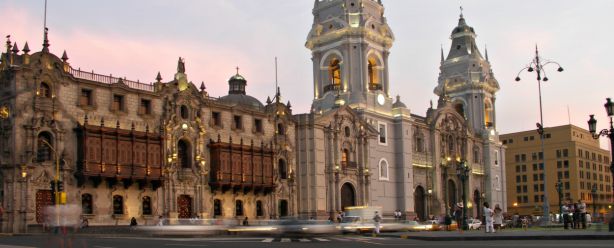This day in 1535, the city of Lima was founded by the Spanish conquistador Francisco Pizarro. To mark the Peruvian capital’s anniversary, we’ve taken a closer look at the past and present of this beautiful port – and the reasons why it makes such a popular destination on ultra-luxury cruises:
 A quick history
A quick history
Inspired by Cortés’s conquest of the Aztecs in Mexico, Pizarro set his sights on the Incan Empire further to the south in Peru. After several attempts of various success, his expeditionary force eventually took control of the country, and the new capital city was born.
Pizarro gave his new city the modest, unassuming title of “The City of the Kings”. The original settlement’s name won out, however – named Lima-Limaq in the Aymara language, meaning “yellow flower”.
The city at a glance
 Lima is a huge city, and with just over eight million residents it has roughly the same population as New York City – a third of all Peruvians live here. Lima is much more spread out, however, and noticeably more affluent than much of the rest of Peru. Miraflores is a hugely popular part of the city for visitors, with much of the city’s shops, casinos and up-scale homes concentrated in this area; San Isidro and La Molina are equally beautiful areas to explore.
Lima is a huge city, and with just over eight million residents it has roughly the same population as New York City – a third of all Peruvians live here. Lima is much more spread out, however, and noticeably more affluent than much of the rest of Peru. Miraflores is a hugely popular part of the city for visitors, with much of the city’s shops, casinos and up-scale homes concentrated in this area; San Isidro and La Molina are equally beautiful areas to explore.
Districts like Los Conos and Villa El Salvador are much poorer by comparison, and more reminiscent of favelas that you’re likely to find in Brazil. In the past, a reputation for crime has hung over Lima’s head – but the past few years have seen much more focus on the visitors who come to see the city. Lima’s central monuments have benefitted from something of a clean-up, along with a more comprehensive police presence in the city’s tourist centres.
The food
 What Peru lacks in material wealth, it makes up for in good food. It’s something of a running theme of discussion between locals and visitors in Lima, and a sure-fire topic to strike up conversation. Markets like Surquillo demonstrate the variety of meat, cheese, fruits and veggies on offer (look out for avocadoes here, which seem to come in novelty size). But you can also get a taste for everyday life in Lima here in the shops and markets, with some time spent in the company of the locals.
What Peru lacks in material wealth, it makes up for in good food. It’s something of a running theme of discussion between locals and visitors in Lima, and a sure-fire topic to strike up conversation. Markets like Surquillo demonstrate the variety of meat, cheese, fruits and veggies on offer (look out for avocadoes here, which seem to come in novelty size). But you can also get a taste for everyday life in Lima here in the shops and markets, with some time spent in the company of the locals.
Fish lovers should definitely try a dish of citrusy ceviche during their visit – after all, if it’s good enough to warrant a Peruvian national holiday, so close is it to the nation’s heart, surely it’s worth a taste while you’re here. Pisco is the favoured local drink, a varied and aromatic grape brandy introduced by Spanish settlers.
The attractions
Lima’s old centre is beautiful – so much so that its varied colonial landmarks have earned it status as a UNESCO World Heritage Site. You’ll find little here in the way of traditional Peruvian architecture – this is the realm of elaborate stonework and ornate dark-wood balconies, hallmarks of the classical Spanish style.
The twin baroque towers of both Lima Cathedral and San Francisco Monastery are among the most recognisable, and popular, landmarks in the city. The monastery stands out in striking pale yellow on the outside, but houses some pretty grim geometric patterns beyond its white-cloistered courtyard, down in the catacombs. The white cathedral on the main Plaza Mayor is perhaps the city’s more famous landmark, and the elegant gold and white vaulted ceilings of its interior doesn’t disappoint those who take a look inside.
 For a taste of the native Peruvian culture, the Indian Market or the Pachacamac ruins could be a good alternative. Lima cruises often include shore excursions to these ruins, an incredible site filled with the remnants of homes, temples and stepped pyramids. The Incas are perhaps synonymous with gold – Pizarro knew it when he invaded, and the Gold Museum by the ruins can illustrate just how much incentive there was for the conquistadors to come to Peru. You’ll find jewelry and tools here in gold and silver, as well as a range of weaponry and the kind of gold statues that could well bring out the Indiana Jones in you. (Re-enacting the famous scene is not advised).
For a taste of the native Peruvian culture, the Indian Market or the Pachacamac ruins could be a good alternative. Lima cruises often include shore excursions to these ruins, an incredible site filled with the remnants of homes, temples and stepped pyramids. The Incas are perhaps synonymous with gold – Pizarro knew it when he invaded, and the Gold Museum by the ruins can illustrate just how much incentive there was for the conquistadors to come to Peru. You’ll find jewelry and tools here in gold and silver, as well as a range of weaponry and the kind of gold statues that could well bring out the Indiana Jones in you. (Re-enacting the famous scene is not advised).
Other attractions around Lima include the Larco Herrara Museum, home to an equally incredible wealth of Incan jewellery and stoneware; and the Casa Aliaga, an ornate stately home practically unchanged since Pizarro gifted it to his captain, de Aliaga, in 1535. If it’s romance on your mind rather than colonial history, the Parque del Amor might be more your thing. It’s one of several scenic parks lining the malecon, the esplanade that runs parallel to the cliffs overlooking the Pacific – marked out by sweeping mosaic seats, and a well-known statue of two lovers kissing.
Images courtesy of Dtarazona and M. González Olaechea y Franco




Comments: no replies